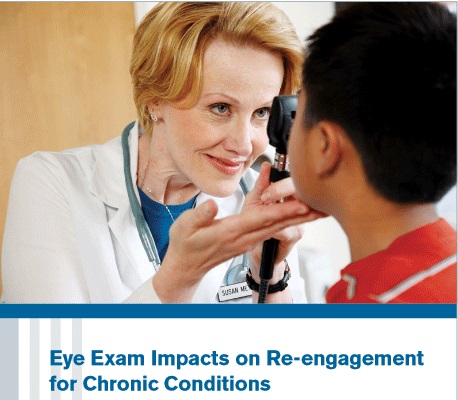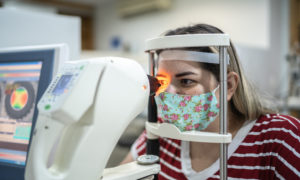
May 27, 2015
A new UnitedHealthcare study shows that 57 percent of patients with chronic conditions who receive a comprehensive eye exam became re-engaged with a primary care physician or specialist in managing their ongoing illness. In addition, the study also showed that employers that adopt integrated eye health and medical benefits, along with health and wellness programs, may improve employee well-being and reduce medical costs.
The “Eye Exam Impacts on Re-engagement for Chronic Conditions” study followed 2,300 UnitedHealthcare plan participants enrolled in employee-sponsored health plans to determine whether patients lacking care for chronic conditions followed up for treatment with a primary care physician or specialist after an eye exam. The study examined re-engagement rates for people with seven chronic conditions—Crohn’s disease, diabetes, Graves’ disease, high cholesterol, hypertension, multiple sclerosis and rheumatoid arthritis. The results are important considering many people visit their eyecare doctor more frequently than their primary care provider.
The results could have a wide-ranging impact on a large proportion of the US population. More than 117 million people nationwide, nearly half of the adults in this country, suffer from at least one chronic condition, while one quarter of adults have two or more conditions, according to the Centers for Disease Control and Prevention (CDC). More than 29 million people have diabetes; 73.5 million have high LDL cholesterol; and 70 million have hypertension, according to the CDC.
“Helping people realize that it’s not just diabetes and hypertension that can be detected by an eye exam can help get patients into treatment early and help cut health care costs,” Linda Chous, OD, chief eyecare officer for UnitedHealthcare Vision, told Vision Monday’s VMail. “Re-engaging these patients into care, eyecare practitioners can help contribute to improved patient health and reduced costs.”
The new report builds on the findings of a previous UnitedHealthcare study, “Impact of Eye Exams in Identifying Chronic Conditions,” published in 2014, as reported in VMail, which demonstrated how comprehensive eye exams can help eyecare doctors identify some chronic conditions, such as high cholesterol, hypertension, rheumatoid arthritis, juvenile rheumatoid arthritis, Crohn’s disease and Graves’ disease.
To support employers’ recognition of the increasing role eye health plays in overall health, UnitedHealthcare’s Bridge2Health, integrated vision and medical benefits program provides patients and health care professionals with information toward making decisions and improving outcomes. Among Bridge2Health’s services are integrating medical and vision data to close gaps in care, including monitoring 23 chronic conditions, identifying people with chronic conditions for ECPs and ensuring that patients’ eyes are dilated during the exam, contacting plan participants with chronic conditions with eye exam reminders and referring people with diabetes to disease management programs.
More than 170 companies representing 5.3 million plan participants have already selected Bridge2Health’s integrated approach for vision benefits to help create healthier employees, lower health care costs and increase productivity.



























